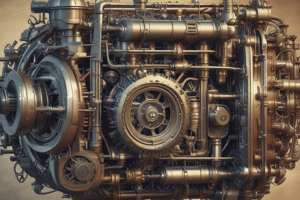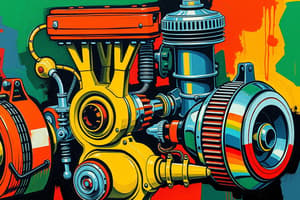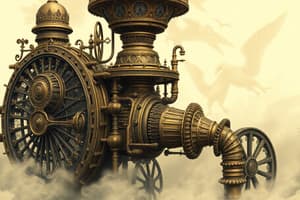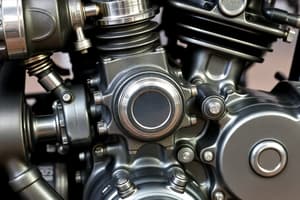Podcast
Questions and Answers
What does BMEP stand for in the context of gasoline engines?
What does BMEP stand for in the context of gasoline engines?
- Base Mean Efficiency Point
- Brake Mean Effective Pressure (correct)
- Brake Mass Energy Production
- Boosted Mean Energy Performance
Which of the following accurately describes η_brake?
Which of the following accurately describes η_brake?
- It is the ratio of the power generated to the total engine displacement.
- It represents the thermal energy lost during combustion.
- It directly indicates the maximum RPM achievable by the engine.
- It measures the brake power output relative to fuel energy input. (correct)
At what RPM is the engine performance data provided?
At what RPM is the engine performance data provided?
- 2000 RPM (correct)
- 4000 RPM
- 1000 RPM
- 3000 RPM
What does CR stand for in the context of engine specifications?
What does CR stand for in the context of engine specifications?
Which fuel charge type is not mentioned in the context provided?
Which fuel charge type is not mentioned in the context provided?
What is the primary characteristic of the heat addition process in the Otto cycle?
What is the primary characteristic of the heat addition process in the Otto cycle?
Which process in the Otto cycle is responsible for the conversion of thermal energy to work?
Which process in the Otto cycle is responsible for the conversion of thermal energy to work?
In the Otto cycle, which relationship correctly defines the cycle efficiency?
In the Otto cycle, which relationship correctly defines the cycle efficiency?
During which phase does the intake/compression take place in the Otto cycle?
During which phase does the intake/compression take place in the Otto cycle?
What does 2Q3 represent in the Otto cycle equation?
What does 2Q3 represent in the Otto cycle equation?
Which statement about specific heats (Cp, Cv) in the Otto cycle is true?
Which statement about specific heats (Cp, Cv) in the Otto cycle is true?
What is the primary purpose of the constant volume heat removal in the Otto cycle?
What is the primary purpose of the constant volume heat removal in the Otto cycle?
What type of process occurs between states 3 and 4 in the Otto cycle?
What type of process occurs between states 3 and 4 in the Otto cycle?
Which statement best describes the differences in efficiency between SI and CI engines?
Which statement best describes the differences in efficiency between SI and CI engines?
What is the typical compression ratio (CR) range for SI gasoline engines?
What is the typical compression ratio (CR) range for SI gasoline engines?
How is load controlled in a CI engine compared to an SI engine?
How is load controlled in a CI engine compared to an SI engine?
Which factor most significantly contributes to throttling losses in SI engines?
Which factor most significantly contributes to throttling losses in SI engines?
What is the consequence of retarding spark timing in an SI engine?
What is the consequence of retarding spark timing in an SI engine?
What technique can improve the efficiency of ICEs?
What technique can improve the efficiency of ICEs?
What is considered a limitation in the efficiency of gasoline engines?
What is considered a limitation in the efficiency of gasoline engines?
What is a common misconception about the power delivery of an Otto cycle compared to a Diesel cycle?
What is a common misconception about the power delivery of an Otto cycle compared to a Diesel cycle?
What is one advantage of gasoline direct injection (GDI) technology?
What is one advantage of gasoline direct injection (GDI) technology?
Which automakers were among the first to develop GDI technologies?
Which automakers were among the first to develop GDI technologies?
Regarding market penetration, what factor significantly affects U.S. vehicle ownership?
Regarding market penetration, what factor significantly affects U.S. vehicle ownership?
What features characterize a stratified charge in gasoline direct injection?
What features characterize a stratified charge in gasoline direct injection?
What was a key feature of the GDI Ecoboost technology introduced by Ford in 2009?
What was a key feature of the GDI Ecoboost technology introduced by Ford in 2009?
What is the size and design characteristic of the single-cylinder optical engine detailed?
What is the size and design characteristic of the single-cylinder optical engine detailed?
Which statement accurately describes the ownership behavior of U.S. vehicle owners?
Which statement accurately describes the ownership behavior of U.S. vehicle owners?
What does the abbreviation 'P.C.F.I.' stand for in the context of engine technology?
What does the abbreviation 'P.C.F.I.' stand for in the context of engine technology?
What is the main reason diesel cycles are generally more efficient than Otto cycles?
What is the main reason diesel cycles are generally more efficient than Otto cycles?
Which of the following formulas represents the thermodynamic efficiency according to the first law of thermodynamics?
Which of the following formulas represents the thermodynamic efficiency according to the first law of thermodynamics?
What is the primary factor contributing to fuel economy expressed in MPG?
What is the primary factor contributing to fuel economy expressed in MPG?
Which statement about engine and drivetrain efficiency is correct?
Which statement about engine and drivetrain efficiency is correct?
What does the term 'Wprop' represent in the context of vehicle propulsion?
What does the term 'Wprop' represent in the context of vehicle propulsion?
What is the effect of engine losses on vehicle energy distribution?
What is the effect of engine losses on vehicle energy distribution?
In calculating the vehicle's MPG, which variable directly relates to the efficiency of the engine and drivetrain?
In calculating the vehicle's MPG, which variable directly relates to the efficiency of the engine and drivetrain?
Which formula represents practical efficiency in terms of mass of fuel and the heating value of the fuel?
Which formula represents practical efficiency in terms of mass of fuel and the heating value of the fuel?
What does the term 'CD' refer to in the context of vehicle aerodynamics?
What does the term 'CD' refer to in the context of vehicle aerodynamics?
Which of the following is NOT a component of the total energy loss in a vehicle?
Which of the following is NOT a component of the total energy loss in a vehicle?
Flashcards are hidden until you start studying
Study Notes
Otto Cycle: A Cycle of Four Processes
- Consists of four processes: Isentropic Compression, Constant Volume Heat Addition, Isentropic Expansion, and Constant Volume Heat Removal
- Isentropic compression (intake/compression stroke)
- Constant volume heat addition (combustion)
- Isentropic expansion (power stroke)
- Constant volume heat removal (exhaust stroke)
Otto Cycle Efficiency
- Thermal efficiency (ηcycle) is a function of compression ratio (CR) and the specific heat ratio (k)
- The higher the compression ratio, the higher the efficiency
- The higher the specific heat ratio, the higher the efficiency
Otto vs. Diesel
- Otto cycle (constant volume heat addition) delivers more power than Diesel cycle (constant pressure heat addition)
- Gasoline engine is constrained by fuel properties = lower CR
- Typical CR:
- SI gasoline CR = 10:1 to 12:1
- DI diesel CR = 15:1 to 20:1
- Materials are limited by peak pressures and maximum rates of pressure rise
Real Engine P-v Diagram
- SI engine: both fuel and air are throttled to control load (power)
- CI engine: load is controlled by fuel injection pulse width
- Throttling air takes work – up to 20% of power out
- Area represents net work required; eliminate pumping work to increase efficiency
Chemiluminescence during Otto Cycle Combustion
- Piston view imaging, indolene fuel
- Retarding spark timing
- Duration of combustion
- Start of combustion
Improving ICE Efficiency
- HCCI-TC, LEAN-SI-TC, ADV-TC (TC = turbocharging, NA = naturally aspirated (unboosted))
- BMEP = brake mean effective pressure (power)
Efficiency Definitions
- Thermodynamic Efficiency:
- 1st Law: η1st = (Wcycle)/(Qin)
- 2nd Law: η2nd = (Wactual)/(Wmax) = (Wactual)/(Wisentropic)
- Practical Efficiencies:
- Based on the energy content of the fuel and work out of engine: ηf = (Wactual)/(m f ⋅ QHV)
- Based on power required to propel the vehicle: ηp = ( W prop )/(m f ⋅ QHV)
Engine and Drivetrain Efficiency
- Engine Efficiency (ηengine) is affected by heat losses, friction losses, and throttling losses
- Drivetrain Efficiency (η DT ) is approximately 80%
- Overall efficiency (ηtotal) is roughly 15%
Fuel Economy and Engine Efficiency
- Fuel economy is measured in MPG (Miles per Gallon)
- MPG is directly proportional to ηtotal
- MPG is influenced by factors like drag, rolling friction, and engine efficiency
Distribution of Energy in Vehicle
- Engine losses are the largest source of energy loss
Supplemental Materials
- Otto Cycle Process
- Easley at el., DEER 2005
- Single-cylinder optical engine research facility [Sandia]
- Gasoline direct injection (GDI)
Production GDI
- Early adopters: Japanese automakers (Honda, Toyota, Nissan, Mitsubishi)
- Ford introduced Ecoboost technology in 2009
- GM offered 6 GDI engines in 2009
- Hyundai (announced 2009)
Studying That Suits You
Use AI to generate personalized quizzes and flashcards to suit your learning preferences.





